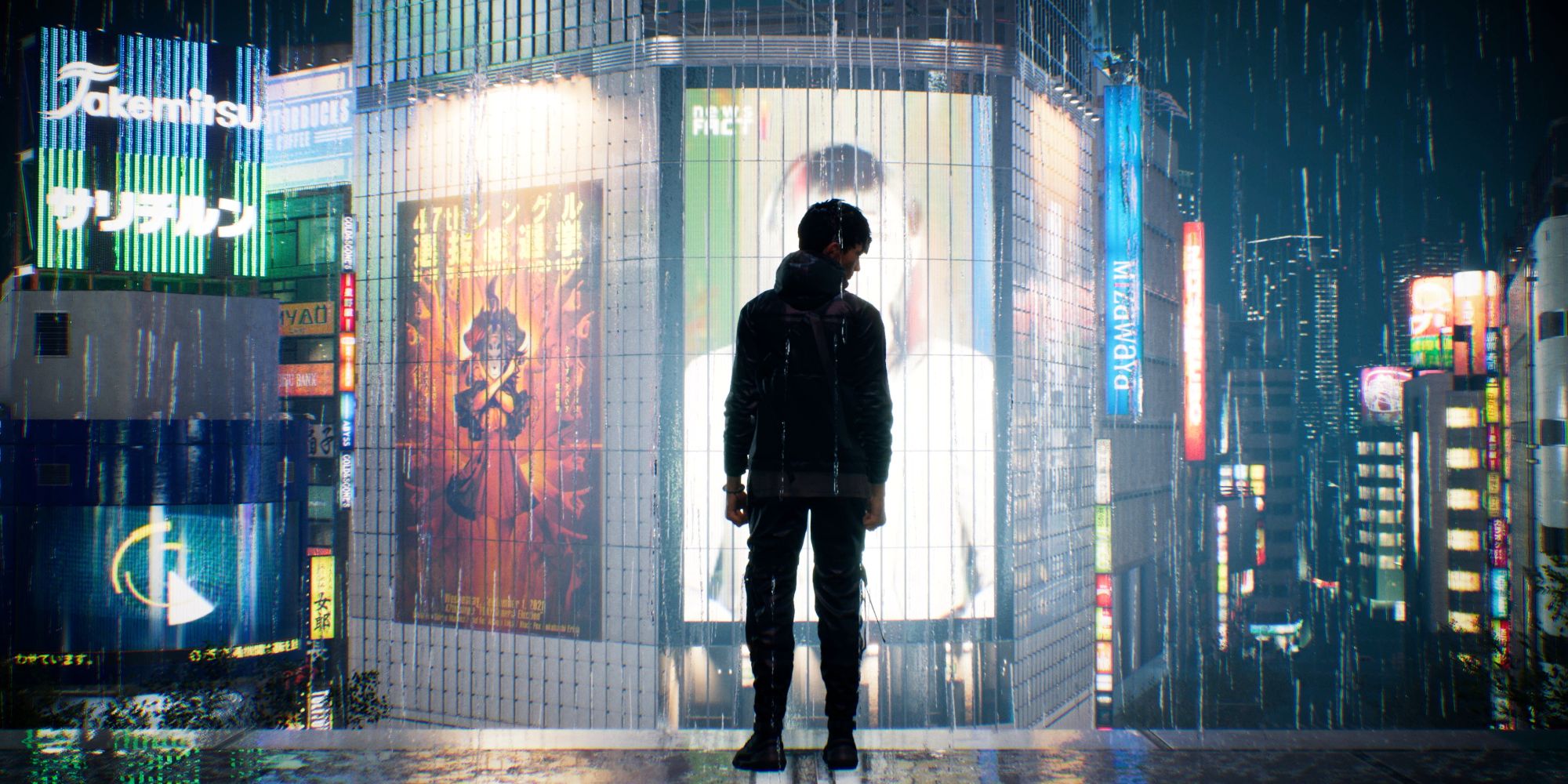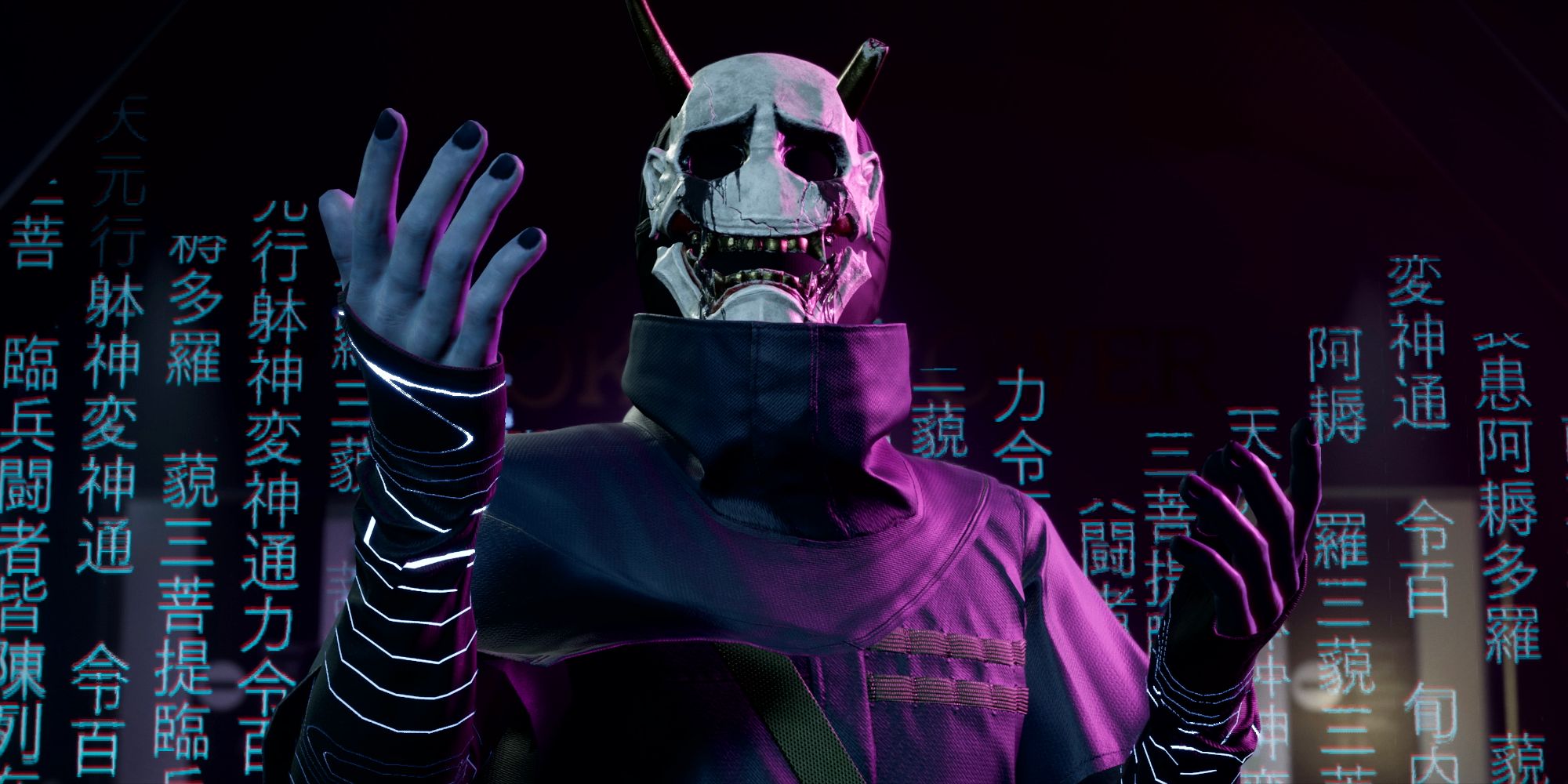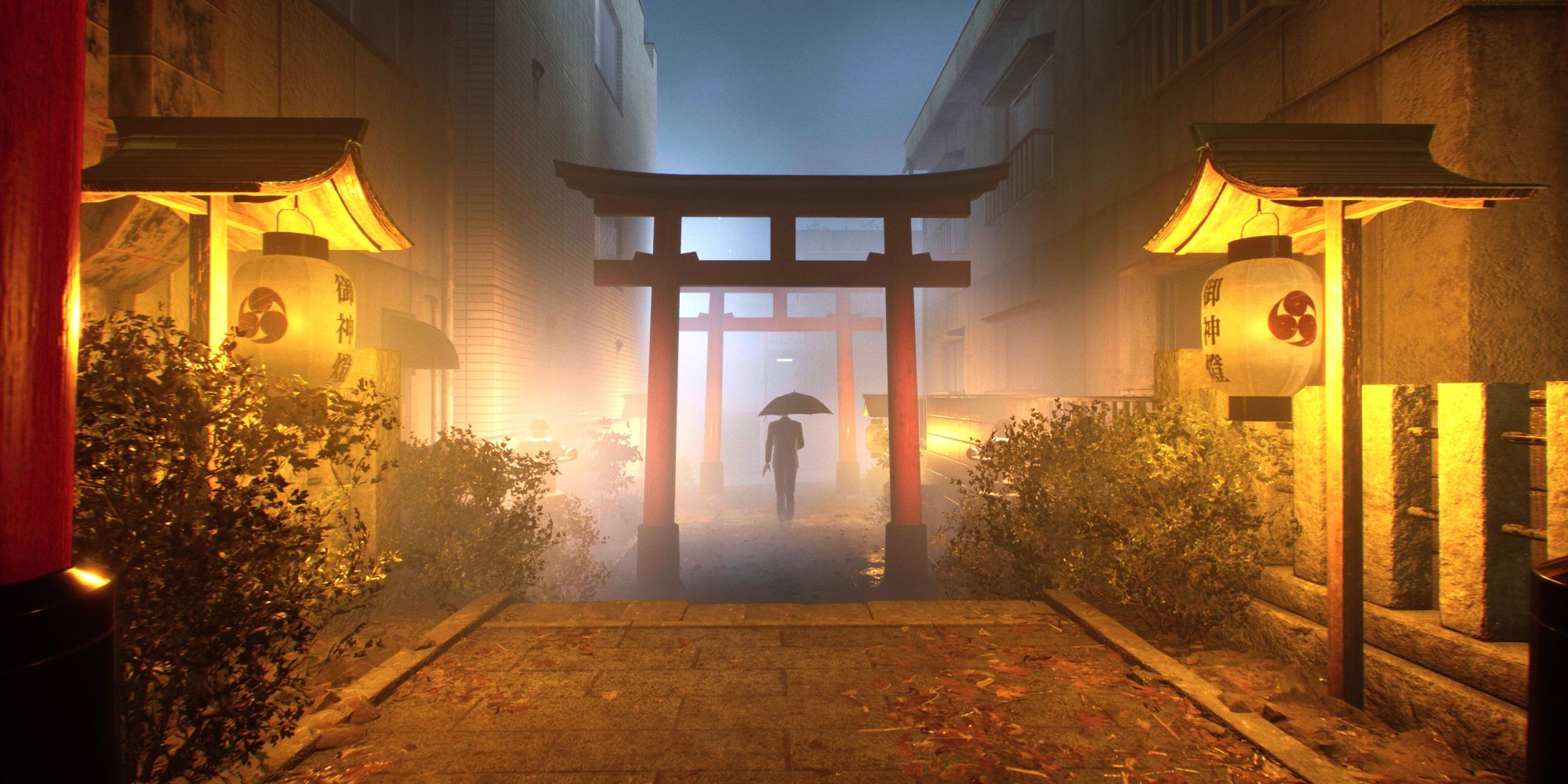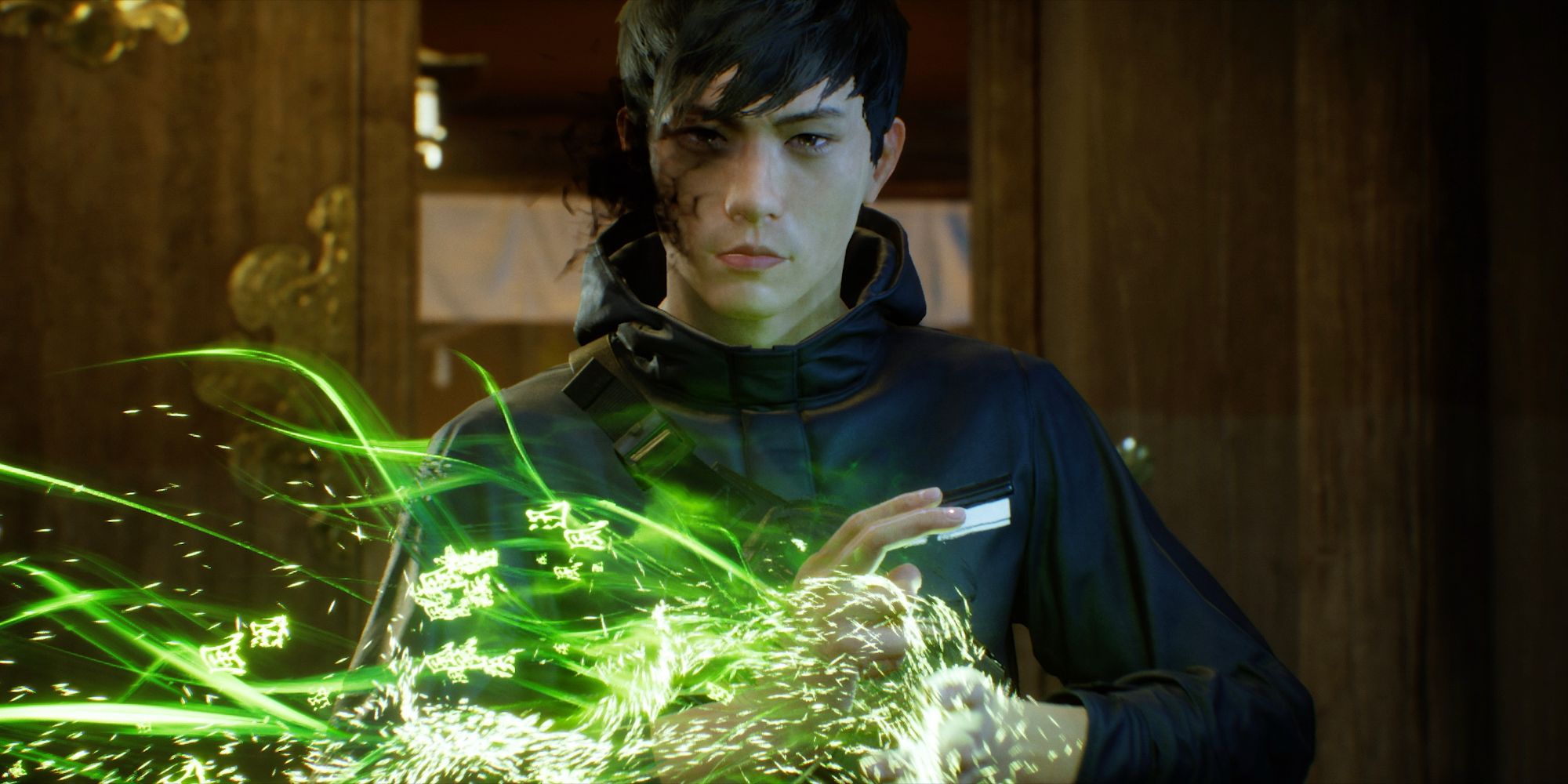The announcement of Ghostwire: Tokyo intrigued many thanks to its eerie, monster filled version of the famous city. That interest was sparked once again when it was revealed that it is an action-adventure game, which is a notable departure from the horror games Tango Gameworks is known for. With curiosity and anticipation rising for Ghostwire: Tokyo, Game Director Kenji Kimura and Producer Masato Kimura chatted with Screen Rant and provide some deeper insights on their upcoming release.
Ghostwire: Tokyo follows Akito after Tokyo is suddenly attacked by paranormal forces. Akito wakes up in the middle of a body-ridden intersection and learns that he was briefly dead, but a spirit named KK is now inhabiting his body and thus resurrected him. KK is trying to use his body to take on the mysterious skull faced villain Hannya, who seems to be behind all of this, but Akito isn’t willing to just give up his body and, instead, wants to use KK’s powers to help save his sister.
After playing through the game’s first two chapters, the story and characters are already deeper and more complex than the setup would suggest. Speaking with Kenji and Masato revealed that, at its core, Ghostwire: Tokyo is a love letter to Japanese culture, art, and the titular city itself. Read on to discover how personal rediscovery, human connection, and Noh (a Japanese style of theatre) became the building blocks of Ghostwire: Tokyo.

As someone who has their degree in theatre, I was really fascinated by all of the references to Noh theatre. Are there any particular plays that inspired the story or the overall design of the game?
Kenji Kimura: The enemy boss character is named Hannya, and he wears a hannya Noh mask. When we looked into creating that mask, we did a lot of research about the Noh mask. It’s a very interesting thing, because it’s a mask that gets used in theaters – traditionally for ceremonies a long time ago in Japan.
The mask is worn by an actual human, but it’s used for an actor who is playing a supernatural entity, like a god. Depending on the way the light hits the mask and the angle at which you are seeing the mask, it could look angry, it could look sad, it could look happy – it can express many different emotions. This was at a time in theater when the theater was done outside. There was no indoor lighting or any of that technology, so by thinking about how that was created and used in that fashion, we did try to use similar thinking in the way we use that mask in the game.
Masato Kimura: Traditional Japanese elements similar to Noh, or that are related to Noh, are seen throughout the game. There are other characters, not just the Hannya character, that wear masks related to Noh theater. Also, music-wise, we are using some Gagaku instruments. Those are instruments that were used in Noh theater a long, long time ago. We are using some very old traditional Japanese instruments in parts of the music.
With the hand actions, like when you’re shooting out ether, there are some hand movements we could probably say are inspired by the Noh theater that we’ve done some research on. Some enemy movements have been partially inspired by martial arts, or by the kind of movements that you would see in the traditional arts in Japan.
Going back to the Hannya mask, was the use of it more for aesthetic reasons and for the ability to show the range of emotion? Or does it hint at something deeper in that character?
Kenji Kimura: It’d be probably both. When we were creating this game, we wanted to make a game that was set in Japan, And when we were doing research about what cool elements of Japan we could put into the game, we did a lot of rediscovery of things that we knew but learned more about by going through this process. The idea of using the Noh mask came out, and then we started doing more research into that and learned that there’s all these cool things about it. So, we started applying that to this character in the game.
Masato Kimura: As we mentioned earlier, the way that light hits the mask can express many different emotions. Depending on the mental state of the viewer, it can also change the way you view the mask. Those were very cool elements, and it’s cool that you picked up on it. We’re happy that you’re bringing it up, and that it’s something that you noticed. We were hoping people would notice it, and it’s good to hear that you have.

Where did the idea to have the “wires” be such a central part of this game mechanically and thematically come from? Did this also come from parts of Japanese theater with puppetry, or is there something more mythological about it?
Kenji Kimura: One of the root concepts of the game was to depict this world that exists – the real world – along with the other world. There was a connection between the two worlds. We were also in a sense creating a story that depicts the connection between characters: some that are living, some that are dead, and some that are just family. People have different relationships, so there’s always a connection between characters.
And also, as part of the game mechanics, we have the ability to expose enemy cores and pull them out using a string. The word “wire” did come up in a lot of different areas during the development of this came as a key word, so it was natural to use that as part of the title of the game. When I think about inspirations, whether unintentional or maybe something that was just in the back of my mind without us really talking about it? There’s a book from Akutagawa Ryunosuke called “Kumo no Ito.” The English title is [The Spider’s Thread]. The thing is that it came up in very various parts of the game design, so it was just natural for us to think of using the word “wire.”
Masato Kimura: The word “connections” was a key word that got used a lot during development: the connections between characters, the connections between this world and the other world, the connections between people and their goals, and the connections between people and their responsibilities. Wires got used to express the connections between those things. Sometimes it’s a connection between the player and the enemy’s core, so it’s used to pull out the core. It was a natural progression in our train of thought to use the word “wire.”
Shifting gears a little bit, I’m curious if any of the enemy designs are references to other things. One of the first examples that came up for me was the creepypasta culture on the internet – primarily with the Umbrella Man being very similar to the character of Slenderman. Are any intentional references that came up in the design?
Kenji Kimura: The enemy spirits that are in Ghostwire are based on strong human emotions that are turned into a reality. Strong human emotions are usually negative emotions, like stress or anxiety or nervousness. The ones that we see appear as enemies are simply based on specific stages in life, where you’re about to change into or go to a new stage in your life. If you’re a preschool child, or if you’re a new kid entering school, you’re always nervous or stressed out about fitting in. Those strong emotions have appeared and turned into a reality, and those are the characters that we see.
Another example you see of that is the umbrella-holding salaryman. That’s also a strong negative emotion felt when you have to join a new job, and you have to fit in with a new company and work specific hours to align yourself with other people – even if you don’t want to. There’s a lot of stress that gets built up together and forms these characters. That’s kind of where our characters came from. And if you look deeper into the umbrella-holding salaryman character that appears in the game, it could look like a salaryman that’s on his way to work and just has an umbrella.
Depending on what your background is and your mental state at the time, just like the Hannya mask that we talked about earlier, it’s up to the player and how the player views what he is looking at. That character can also look like Slenderman, based on what cultural references you’re so used to and which appeal to you. He’s wearing a formal black suit, so it could look like a person that’s going to a funeral. It’s really up to the viewer and the customer. We like that angle of allowing the player to come up with their own interpretation of what they’re looking at.
Masato Kimura: It also kind of goes back to the exercise we did in the beginning about rediscovering what’s cool about Japan and what’s cool about Tokyo. We were thinking that having a young preschool child wearing this raincoat is something that looks cool and is very interesting. School uniforms are something kind of unique to Japan and also pretty cool, so that was also an aspect of why those were chosen.

While watching the gameplay reveal video, there was the mention of transitioning from making horror games to making action-adventure. What was that shift like, and what was the learning curve?
Kenji Kimura: It wasn’t much of a big challenge for us or a steep learning curve when we were thinking about changing the genre, because that was more of a natural evolution from the game. We wanted to make a game that was fun to walk around in and experience the strangeness of Tokyo and the spookiness of it. There was a natural shift into making it fun to explore, so you don’t want to scare the player away from doing exploration. It was just removing that scariness and reducing the stress for players to be able to experience the fun of Tokyo.
That part wasn’t that difficult. It’s the other parts, like making a real and authentic-feeling city inside the game. Creating action and combat that doesn’t use a physical gun, for example, was also a new thing for the studio that felt more like a challenge. But because of those challenges and the way we were able to work together to tackle them, I think we ended up with something really cool and exciting for the players to experience. I just hope that more and more players have the opportunity to experience it.
Of all the various animal characters and different spirits present in the game, which one is your favorite?
Kenji Kimura: It’s hard to answer, because there’s so many cool characters. If I had to spit out one, that would be the Nekomata character, because I like cute characters. The Nekomata is the character that you see as the convenience store clerk in the game, and he’s very cute. But the Nekomata also appears in different parts of the game as a hobbyist collector of Japanese traditional items as you progress in the game. It will say stuff like, “I wish I had this; I wish I had that,” and you can go find those items for him and bring them back to sell to him.
For example, the Nekomata might like collecting a kabuto – which is like a Shogun helmet. You’d go find that kabuto and bring it back, and the Nekomata would say, “Thank you for that,” and also would actually put it on his own head and wear it. Or it could be a kanzashi, which would be a Japanese traditional hairpiece like a comb, that he’d want. You’d go find it and he’d put it into his hair, or he might just put it on display behind him. It’s very cute.
Masato Kimura: My favorite character is KK. Not the visual of KK, but just as a person or spirit. He seems like just an older guy, but I don’t want to spoil it for you. Please play the game to the end, and you’ll start to see why KK is so alluring. The emotional story arc allows for relationship changes. It kind of goes back to the key word of “connection,” but the way the two characters connect and the way KK connects with other characters will be very interesting and appealing to a hopefully a lot of people.

Ghostwire: Tokyo releases on March 25, 2022 for Playstation 5 and PC. Screen Rant was provided with a PS5 download code for the purpose of this interview.




